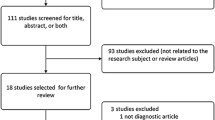Abstract
Purpose
The aim of this study was to investigate the clinical usefulness of acoustic radiation force impulse (ARFI) imaging for the differential diagnosis of breast lesions.
Materials and methods
We studied 40 solid mass lesions from a total of 40 patients (age range 29–67 years, mean 50 years). There were 18 benign lesions and 22 malignant tumors. ARFI imaging was performed using Virtual Touch tissue imaging. We examined the possibility of lesions seen on B-mode images being visually confirmed on ARFI images. When the lesion was visually confirmed, the lesions that were bright or dark inside were classified into patterns 1 and patterns 3, respectively. The lesions that failed to be visually confirmed were classified as pattern 2.
Results
There were 3 pattern 1 lesions and 7 pattern 2 lesions; all of these lesions were benign. The remaining 8 benign lesions and 22 malignant lesions were determined to be pattern 3. The negative predictive value was 100%.
Conclusion
ARFI imaging is a potentially promising ultrasonographic technique for the differential diagnosis of breast lesions, particularly complicated cysts without a cystic component on B-mode images.
Similar content being viewed by others
References
Stavros AT, Thickman D, Rapp CL, Dennis MA, Parker SH, Sisney GA. Solid breast nodules: use of sonography to distinguish between benign and malignant lesions. Radiology 1995;196:123–134.
Zonderland HM, Coerkamp EG, Hermans J, van de Vijver MJ, van Voorthuisen AE. Diagnosis of breast cancer: contribution of US as an adjunct to mammography. Radiology 1999;213:413–422.
Flobbe K, Nelemans PJ, Kessels AG, Beets GL, von Meyenfeldt MF, van Engelshoven JM. The role of ultrasonography as an adjunct to mammography in the detection of breast cancer—a systematic review. Eur J Cancer 2002;38:1044–1050.
Cosgrove DO, Kedar RP, Bamber JC, al-Murrani B, Davey JB, Fisher C, et al. Breast diseases: color Doppler US in differential diagnosis. Radiology 1993;189:99–104.
Raza S, Baum JK. Solid breast lesions: evaluation with power Doppler US. Radiology 1997;203:164–168.
Itoh A, Ueno E, Tohno E, Kamma H, Takahashi H, Shiina T, et al. Breast disease: clinical application of US elastography for diagnosis. Radiology 2006;239:341–350.
Athanasiou A, Tardivon A, Tanter M, Sigal-Zafrani B, Bercoff J, Deffieux T, et al. Breast lesions: quantitative elastography with supersonic shear imaging-preliminary results. Radiology 2010;256:297–303.
Berg WA, Sechtin AG, Marques H, Zhang Z. Cystic breast masses and the ACRIN 6666 experience. Radiol Clin North Am 2010;48:931–987.
Tardivon A, El Khoury C, Thibault F, Wyler A, Barreau B, Neuenschwander S. Elastography of the breast: a prospective study of 122 lesions. J Radiol 2007;88:657–662.
Schaefer FK, Heer I, Schaefer PJ, Mundhenke C, Osterholz S, Order BM, et al. Breast ultrasound elastography: results of 193 breast lesions in a prospective study with histopathologic correlation. Eur J Radiol 2011;77:450–456.
Wojcinski S, Farrokh A, Weber S, Thomas A, Fischer T, Slowinski T, et al. Multicenter study of ultrasound real-time tissue elastography in 779 cases for the assessment of breast lesions: improved diagnostic performance by combining the BI-RADS(R)-US classification system with sonoelastography. Ultraschall Med 2010;31:484–491.
Regini E, Bagnera S, Tota D, Campanino P, Luparia A, Barisone F, et al. Role of sonoelastography in characterising breast nodules: preliminary experience with 120 lesions. Radiol Med 2010;115:551–562.
Raza S, Odulate A, Ong EM, Chikarmane S, Harston CW. Using real-time tissue elastography for breast lesion evaluation: our initial experience. J Ultrasound Med 2010;29:551–563.
Zhi H, Xiao XY, Yang HY, Wen YL, Ou B, Luo BM, et al. Semi-quantitating stiffness of breast solid lesions in ultrasonic elastography. Acad Radiol 2008;15:1347–1353.
Cho N, Moon WK, Kim HY, Chang JM, Park SH, Lyou CY. Sonoelastographic strain index for differentiation of benign and malignant nonpalpable breast masses. J Ultrasound Med 2010;29:1–7.
Sohn YM, Kim MJ, Kim EK, Kwak JY, Moon HJ, Kim SJ. Sonographic elastography combined with conventional sonography: how much is it helpful for diagnostic performance? J Ultrasound Med 2009;28:413–420.
Berg WA, Campassi CI, Ioffe OB. Cystic lesions of the breast: sonographic-pathologic correlation. Radiology 2003;227:183–191.
Author information
Authors and Affiliations
Corresponding author
About this article
Cite this article
Tozaki, M., Isobe, S., Yamaguchi, M. et al. Ultrasonographic elastography of the breast using acoustic radiation force impulse technology: preliminary study. Jpn J Radiol 29, 452–456 (2011). https://doi.org/10.1007/s11604-011-0561-2
Received:
Accepted:
Published:
Issue Date:
DOI: https://doi.org/10.1007/s11604-011-0561-2




